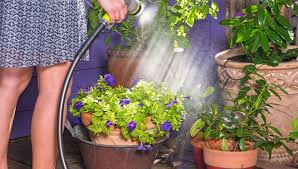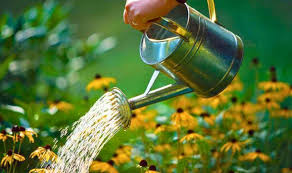Indoor plants bring a touch of nature into our homes, enhancing both aesthetics and air quality. However, one of the most critical aspects of indoor plant care is proper watering. Overwatering or underwatering can lead to a host of problems, including root rot, leaf drop, and poor plant health. This guide will delve into the essentials of watering your houseplants effectively, ensuring they thrive and add beauty to your space.
1. Understanding Your Plant’s Watering Needs

Different plants have varied watering requirements based on their type, size, and environmental conditions. Understanding these needs is the first step in proper plant care.
1.1 Types of Houseplants
- Succulents and Cacti: These plants are adapted to arid environments and require minimal watering. They thrive on infrequent watering and prefer to dry out completely between waterings.
- Tropical Plants: Plants like pothos, peace lilies, and ferns thrive in humid environments and generally need more frequent watering.
- Herbs and Vegetables: Indoor herbs and vegetables often need consistent moisture to grow well. They require regular watering and should not be allowed to dry out completely.
1.2 Factors Affecting Watering Needs
- Light Levels: Plants in bright, sunny spots typically require more frequent watering compared to those in lower light conditions.
- Temperature and Humidity: Higher temperatures and low humidity levels increase the evaporation rate, necessitating more frequent watering.
- Pot Size and Type: Larger pots and porous materials like terracotta dry out faster than smaller pots and non-porous materials like plastic.
2. Determining When to Water Your Plants
One of the most common mistakes in indoor plant care is improper watering. To avoid this, you need to determine the right time to water your plants.
2.1 Check Soil Moisture
The best way to assess when to water is by checking the soil moisture. Here are some methods:
- Finger Test: Insert your finger about an inch into the soil. If it feels dry at that depth, it’s time to water. If it feels moist, hold off on watering.
- Soil Moisture Meter: These devices measure soil moisture levels and can provide a more accurate reading.
- Lift the Pot: A pot with dry soil will feel lighter compared to a pot with moist soil. Lift the pot to gauge its weight as an additional indicator.
2.2 Signs of Overwatering and Underwatering
Recognizing signs of overwatering or underwatering can help you adjust your watering practices:
- Overwatering: Yellowing leaves, root rot, moldy soil surface, and a soggy pot are indicators of overwatering.
- Underwatering: Wilting, brown leaf edges, dry soil, and slow growth are signs that your plant may need more water.
3. Proper Watering Techniques

Once you’ve determined when to water your plants, use the following techniques to ensure you’re watering them properly.
3.1 Water Evenly
Ensure that you water your plant evenly so that the entire root system receives moisture. Water until you see excess water draining from the bottom of the pot. This ensures that the water reaches the entire root zone.
3.2 Avoid Waterlogging
Make sure your pots have drainage holes to prevent water from pooling at the bottom. Waterlogging can lead to root rot and other issues. If your pots lack drainage, consider repotting your plants into containers with drainage holes.
3.3 Use Room Temperature Water
Cold water can shock plant roots, while water that’s too hot can harm them. Use room temperature water to avoid any adverse effects.
3.4 Water in the Morning
Watering in the morning allows plants to absorb moisture before the heat of the day. This also helps reduce the risk of fungal diseases, which can thrive in the moisture of the evening.
4. Watering Strategies for Different Types of Houseplants
Different types of houseplants may require tailored watering strategies:
4.1 Succulents and Cacti
Water these plants thoroughly, but infrequently. Allow the soil to dry out completely between waterings. During the winter months, reduce watering as these plants enter a dormant phase.
4.2 Tropical Plants
Keep the soil consistently moist but not waterlogged. Increase humidity levels around these plants by misting them regularly or placing a humidifier nearby.
4.3 Herbs and Vegetables
These plants generally require consistent moisture. Water them regularly, checking the soil’s top layer to ensure it’s not dry. Use a drip irrigation system for convenience if you have multiple herbs or vegetables.
5. Seasonal Watering Adjustments
Plants’ watering needs can change with the seasons. Adjust your watering practices based on seasonal conditions:
5.1 Spring and Summer
During these warmer months, plants typically require more frequent watering due to increased evaporation and growth. Monitor soil moisture more closely and adjust your watering schedule as needed.
5.2 Fall and Winter
In cooler months, many plants enter a dormant or slower growth phase, reducing their water requirements. Water less frequently and ensure that the soil doesn’t remain soggy.
6. Common Watering Mistakes to Avoid

Avoiding common mistakes can help keep your plants healthy:
6.1 Watering on a Set Schedule
Plants’ water needs vary based on environmental conditions. Avoid watering on a strict schedule and instead, check soil moisture levels regularly.
6.2 Using Cold Water
Cold water can shock plant roots. Always use room temperature water to avoid causing harm to your plants.
6.3 Overwatering
Overwatering is a common issue that can lead to root rot and other problems. Ensure that the soil dries out between waterings and always check for drainage.
Conclusion
Proper watering is essential for maintaining healthy indoor plants. By understanding your plants’ specific needs, determining the right time to water, and using effective watering techniques, you can ensure that your houseplants thrive and enhance your indoor environment. Regularly checking soil moisture, adjusting watering practices based on seasons, and avoiding common mistakes will help you keep your plants healthy and beautiful throughout the year. With the right care, your indoor plants will continue to bring joy and freshness to your home.



